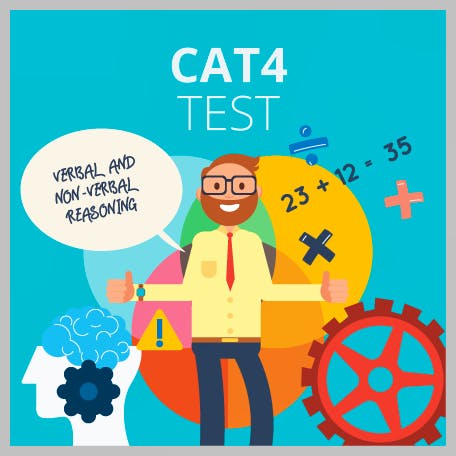A Guide to the CAT4 Test Level D: Tips & Examples
Updated July 12, 2024

- What Is the CAT4 Level D Test?
- What Does the CAT4 Level D Measure?
- What Type of Questions Are on the CAT 4 Level D?
- How Is the CAT4 Level D Test Structured?
- CAT4 Level D Sample Questions
empty
empty
empty
- How Is the CAT4 Level D Scored?
empty
- How to Help Children Prepare for the CAT 4 Level D Test
- Frequently Asked Questions
- Final Thoughts

The CAT4 Level D is a cognitive ability test used by a number of UK secondary schools. Typically taken by pupils in Year 7, the CAT4 Level D tests a child’s verbal, non-verbal, quantitative and spatial reasoning skills to give an accurate picture of their learning potential.
Designed and published by GL Assessment, the Cognitive Abilities Test – better known as CAT4 – is an assessment series used by primary and secondary schools across the UK.
The CAT4 test is administered at different levels ranging from A to G, each level appropriate for a different age group.
- CAT4 Test Practice for Year 2 (Level X)
- CAT4 Test Practice for Year 4 (Level A)
- CAT4 Test Practice for Year 5 (Level B)
- CAT4 Test Practice for Year 6 (Level C)
- CAT4 Test Practice for Year 7 (Level D)
- CAT4 Test Practice for Year 8 (Level E)
- CAT4 Test Practice for Year 9 & Year 10 (Level F)
- CAT4 Test Practice for Year 11+ (Level G)
This article looks specifically at the CAT4 Level D.
It covers everything you need to know about the test and how to help your child prepare. It also includes some CAT4 Level D sample questions for practice.
What Is the CAT4 Level D Test?
The CAT4 Level D test is the version of the CAT4 aimed at pupils aged between 10 years, six months and 12 years, 11 months – i.e. those in Year 7 if at school in England and Wales, Senior 1 pupils in Scotland, and those in Year 8 in Northern Ireland.
The CAT4 Level D is not a compulsory test, so not every student will sit this assessment.
It is however used by a growing number of schools. This is because it looks at capacity for learning rather than learned knowledge, giving teachers and parents a better idea of each child’s potential.
CAT4 Level D results can be used to understand a pupil’s learning style, where they might excel or where they might need additional support.
They can also be used to place pupils in the right ability sets for subjects like English and Maths, and to indicate performance potential for compulsory exams like GCSEs.
What Does the CAT4 Level D Measure?
All CAT4 levels test the same key areas of cognitive ability, the CAT4 Level D included. These are:
- Verbal reasoning – The ability to both interpret and express ideas through words
- Non-verbal reasoning – The ability to solve picture-based and diagrammatic problems
- Quantitative reasoning – The ability to solve problems by working with numbers
- Spatial reasoning – The ability to think and work in three dimensions
These skills are not subject-specific. For example, though it relates to language use, verbal reasoning is not just a useful skill for English. It is also useful for other language-heavy subjects like History and Geography.
Quantitative, spatial and non-verbal reasoning skills are required for multiple subjects including Maths, Science and Design and Technology.
What Type of Questions Are on the CAT 4 Level D?
The cognitive abilities measured by the CAT4 Level D are referred to as test batteries. Each one of these batteries has two question types associated with it.
For the verbal reasoning battery, these question types are:
- Verbal classification – Pupils must identify a link between three words and find a fourth word with a similar meaning.
- Verbal analogies – Pupils must identify the relationship in a complete word pairing and use it to find the missing part of an incomplete word pairing.
For the non-verbal reasoning battery, the question types are:
- Figure classification – Pupils will see three shapes with a common link between them. They must then choose a fourth shape that shares that same characteristic.
- Figure matrices – Pupils will need to spot rules and relationships in one figure pairing to complete a second.
For the quantitative reasoning battery, the question types are:
- Number analogies – Pupils will see three pairs of numbers, two complete and one incomplete. They’ll need to work out how the numbers in the first two pairs are related to each other to find the missing number from the third.
- Number series – Pupils must work out the rule of progression in a sequence of numbers to find the next number along.
For the spatial reasoning battery, the question types are:
- Figure analysis – Pupils must mentally work out how a square that has been repeatedly folded and hole punched would look when unfolded.
- Figure recognition – Pupils must analyse five line drawings to determine which one contains a given target shape.
How Is the CAT4 Level D Test Structured?
The CAT4 Level D is split into three individual tests. These are taken with breaks in between, or sometimes over three consecutive days so as not to overwhelm pupils.
How the test is administered will be down to the school in question.
Each of the three tests is around 45 minutes long. This includes the time it takes to:
- Get pupils settled in their seats
- Issue instructions
- Take a short CAT 4 Level D practice test
- Complete the official test itself
The three parts of the CAT 4 Level D are structured as follows:
CAT4 Level D Part 1:
- 24 Figure Classification questions in 10 minutes
- 24 Figure Matrices questions in 10 minutes
CAT4 Level D Part 2:
- 24 Verbal Classification questions in 8 minutes
- 24 Verbal Analogies questions in 8 minutes
- 18 Number Analogies questions in 10 minutes
CAT4 Level D Part 3:
- 18 Number Series questions in 8 minutes
- 18 Figure Analysis questions in 9 minutes
- 18 Figure Recognition questions in 9 minutes
Each part of the test is multiple-choice, with pupils given five possible answers for every question.
The CAT4 Level D can be issued as either a paper or digital test. The same structure applies to both versions.
CAT4 Level D Sample Questions
Verbal Classification
Which of the five multiple-choice options is a word that most closely matches the meaning of the following three words:
Shy | Nervous | Hesitant
a) Unwilling
b) Timid
c) Unfriendly
d) Quiet
e) Lonely
Which of the multiple-choice options has the same relationship to the third word as the relationship shared by words one and two:
Green > Colour : Hat > ?
a) Head
b) Warmth
c) Fashion
d) Clothing
e) Scarf
Which of the multiple-choice options comes next in the number series below:
5, 10, 17, 22, 29, 34, 41, ?
a) 45
b) 46
c) 47
d) 48
e) 49
If you want 12-month access to all the practice resources for this test, our partner TestHQ offers a CAT4 Premium Package.
Family Membership gives you access to all the TestHQ resources for the next 12 months. You will also get two separate accounts, which can be very helpful if you have two children preparing for their tests.
How Is the CAT4 Level D Scored?
If taken digitally, the CAT4 Level D is marked automatically as soon as a pupil completes the test.
For the paper version, all answer sheets must be sent off to be marked by a computer.
Educators are then given a comprehensive score report for each pupil.
CAT test scores are given in various forms. First, a raw score is given for each part of the test. This shows how many questions the pupil answered correctly.
These raw scores are then compared with the CAT test scores of other pupils in the same age range to provide three normative scores – National Percentile Rank (NPR), Standard Age Scores (SAS) and scores on the Stanine Scale.
Year 7 CAT Scores Explained
Below you’ll find each of the normative CAT test scores explained in more detail:
- National Percentile Rank – This shows how many pupils in the same age range achieved an equivalent score or below. For example, if your child achieves a percentile rank of 80, it means they scored as highly as or higher than 80% of pupils in their age group.
- Standard Age Score – These are scores given on a standardised scale where the average score is set at 100, with a standard deviation of 15. Scores between 112 and 126 are considered above average, with a score of 127 or above very high.
- Stanines – Stanine is perhaps the easiest score to interpret. A score is awarded on a standardised scale from 1 to 9, with 1 considered very low and 9 very high. Scores of 4, 5 and 6 are considered average
If you need your child’s Year 7 CAT scores explained further, their teacher should be able to provide more information on how they are interpreted.

How to Help Children Prepare for the CAT 4 Level D Test
Step 1. Help Them Expand Their Vocabulary
For the verbal reasoning sections on the CAT4 Level D, children need to recognise a wide range of words, understand how word meanings can change depending on context and identify relationships between words.
Try introducing them to language they wouldn’t typically come across by reading new books or completing age-appropriate crosswords.
You could also encourage them to keep a vocabulary diary, where they make note of the new words they learn, and play games like word of the day and word pairs.
Step 2. Play Logic Games and Puzzles
Thinking in 3D and mentally manipulating shapes is a key skill for the CAT4 Level D, and there are plenty of fun activities that can help with this.
Lego is a good toy to get children’s brains thinking about shape and form, and games like Tetris can help them with mental manipulation.
You can even recreate the concept of the Figure Analysis questions by repeatedly folding and hole punching pieces of paper, and asking your child to draw what they think that paper will look like once unfolded.
Step 3. Complete CAT 4 Level D Sample Questions
There are plenty of CAT 4 Level D sample questions available, like those above, that will help your child understand what they’ll be asked to do in each section of the test.
Completing a range of these together is a great way to build their confidence.
It’s also a useful way for you as a parent to identify where your child is most capable and where they may need a little extra help. You can then tailor how you help them prepare accordingly.
Step 4. Try a CAT4 Level D Practice Test
Once you’ve completed lots of CAT4 Level D sample questions, try sitting your child down to take a full practice test.
This will get them used to switching from one question type to another, and concentrating for the full length of the test duration.
It’s important here not to put too much pressure on them though. Keep practice tests as lighthearted and as fun as possible.
Step 5. Focus on Wellbeing
In the run-up to the test, and particularly the night or nights before, make sure your child eats a well-balanced diet, stays hydrated and gets a good amount of quality sleep.
Try too to give plenty of reassurance. Any kind of test can be a stressful experience for a lot of children, so it’s important they don’t feel too much pressure.
However you choose to help your child prepare for the CAT4 Level D test, leave plenty of time for recreational activities too.
The CAT4 test is a cognitive ability test used by a number of primary and secondary schools across the UK.
Published by GL Assessment, it is administered at difficulty levels ranging from A to G. Each of the CAT 4 test levels is aimed at a particular educational year group, with tests designed for pupils aged six to 17-plus.
CAT4 test scores are used to determine a pupil’s learning style – and their cognitive strengths and weaknesses – so educators can better support their development.
The CAT4 is taken at different levels that are designed to be age-appropriate and issued as children progress through the educational system.
CAT4 Level D is the test designed for children aged between 10 years and six months and 12 years and 11 months.
This is equivalent to school Year 7 in England and Wales, Senior 1 in Scotland and Year 8 in Northern Ireland.
There are plenty of resources available online that parents can access to help children prepare for the CAT4 Level D test.
As well as the CAT 4 Level D sample questions in this article, you can also access practice tests at TestHQ.
Alongside these practice questions, you can help your child prepare by encouraging them to read more and making word and logic puzzles fun daily activities.
The CAT4 Level D test is designed to be age-appropriate for pupils in Year 7 or equivalent, that is, those aged between 10 and 12 years old.
It’s important to note however that the CAT4 isn’t a pass-or-fail assessment, but rather a tool for understanding a child’s potential and their educational needs.
The CAT4 Level D measures four areas of cognitive ability with two question types for each, meaning a total of eight different question types. These are as follows:
-
Cognitive ability: Verbal reasoning
-
Question types: Verbal Classification and Verbal Analogies
-
Cognitive ability: Non-verbal reasoning
-
Question types: Figure Classification and Figure Matrices
-
Cognitive ability: Quantitative reasoning
-
Question types: Number Analogies and Number Series
-
Cognitive ability: Spatial reasoning
-
Question types: Figure Analysis and Figure Recognition
There is no passing score for the CAT4 Level D as it is not a pass/fail assessment.
Each pupil will be given four separate scores – a raw score, a National Percentile Rank (NPR), a Standard Age Score (SAS) and a score on the Stanine scale (ST). Stanine scores are the easiest to understand, with scores of 4,5 and 6 considered average.
To have your child’s CAT scores explained in full contact the school, as it will have detailed guidance on how to interpret each type of test score.
Sites like TestHQ offer free access to CAT4 Level D sample questions that you can work through with your child.
This will help them understand the nature of each question type and see them become more confident in answering them.
The CAT4 Level D is split into three individual tests, which are further split into two or three subsections. Each complete test lasts around 45 minutes in total.
Included in this time frame is an allowance for settling pupils down, time for giving instructions and time for completing some practice questions for each section.
The actual time given to the official test questions themselves varies from eight minutes to 10 minutes, meaning in any one of the three tests, pupils will spend a maximum of 30 minutes answering marked questions.
CAT4 Level D test results will be sent to the school your child attends, not delivered to the child or parent directly.
Every school will have its own practices in place. Some may choose to discuss CAT4 Level D test results in person, while some may send them out via mail. Some schools may choose not to release CAT 4 Level D results at all.
For more information on its approach, contact the school directly.
As it is a measure of cognitive ability and not learned knowledge, there is no pass mark for the CAT4 Level D.
You can however help your child score highly by working to improve their verbal, non-verbal, quantitative and spatial reasoning abilities.
Try introducing logic puzzles, word games and plenty of reading alongside taking a CAT 4 Level D practice test.
The CAT4 Level D test is administered as either a pen and paper or a computer-based exam. How it is issued will be down to each individual school.
You can find a comprehensive CAT4 Level D preparation pack through TestHQ
This includes a detailed study guide and two full-length CAT4 Level D practice tests. There are also a number of additional sample questions with answer explanations for each.
Final Thoughts
By measuring cognitive ability instead of subject-specific knowledge, the CAT4 Level D shows educators what each pupil is capable of achieving so they can better support their learning.
As the parent of a child preparing for the CAT4 Level D, it’s important to reassure them that it doesn’t have to be a stressful experience and that improving their cognitive abilities can be fun.
Provided you make the right activities a part of daily life, and make sure your child has plenty of time to both play and relax, they should have no trouble performing at their best on the day of their CAT4 Level D test.












